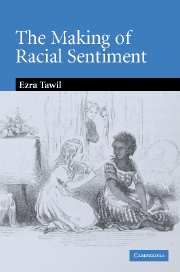Book contents
- Frontmatter
- Contents
- Acknowledgments
- Introduction: Toward a literary history of racial sentiment
- 1 The politics of slavery and the discourse of race, 1787–1840
- 2 Remaking natural rights: race and slavery in James Fenimore Cooper's early writings
- 3 Domestic frontier romance, or, how the sentimental heroine became white
- 4 “Homely legends”: the uses of sentiment in Cooper's The Wept of Wish-Ton-Wish
- 5 Stowe's vanishing Americans: “negro” interiority, captivity, and homecoming in Uncle Tom's Cabin
- Conclusion: Captain Babo's cabin: racial sentiment and the politics of misreading in Benito Cereno
- Notes
- Index
3 - Domestic frontier romance, or, how the sentimental heroine became white
Published online by Cambridge University Press: 22 September 2009
- Frontmatter
- Contents
- Acknowledgments
- Introduction: Toward a literary history of racial sentiment
- 1 The politics of slavery and the discourse of race, 1787–1840
- 2 Remaking natural rights: race and slavery in James Fenimore Cooper's early writings
- 3 Domestic frontier romance, or, how the sentimental heroine became white
- 4 “Homely legends”: the uses of sentiment in Cooper's The Wept of Wish-Ton-Wish
- 5 Stowe's vanishing Americans: “negro” interiority, captivity, and homecoming in Uncle Tom's Cabin
- Conclusion: Captain Babo's cabin: racial sentiment and the politics of misreading in Benito Cereno
- Notes
- Index
Summary
Mary Conant was indeed the wife of Hobomok.
Lydia Maria Child, Hobomok.[I]f one is amused by a contradiction, it is because one supposes its terms to be very far apart.
Roland Barthes, Mythologies.According to the dominant literary critical tradition, the designation “domestic frontier romance” presents a contradiction in terms. Most accounts of American literary history proceed on the assumption that the cultural impulse behind the frontier romance opposes that responsible for domestic fiction. Deliberately shaking off the conventions associated with the homebound novels of European middle-class women, American frontier fiction tells the story of racial warfare set on the line between settlement and wilderness. Gender and genre coalesce here in a familiar manner. The heart of the frontier romance is a masculine hero, neither genteel nor marriageable, who flees the settlement for the freedom of the “virgin land.” Indeed, its story is often told as if the frontier novel itself were one of Mark Twain's late-nineteenth century boy-heroes, turning its back on “sivilization” to “light out for the Territory.” As Leslie Fiedler tells us, the genre veered from “society to nature or nightmare” in order to “avoid the facts of wooing, marriage, and child-bearing” and the entire realm of the “chafing and restrictive” woman-centered home. Where Fiedler seems to celebrate the genre, Richard Slotkin and Philip Fisher, by contrast, have generated powerful critiques of the culture of racialized violence to which this literature contributed.
- Type
- Chapter
- Information
- The Making of Racial SentimentSlavery and the Birth of The Frontier Romance, pp. 92 - 128Publisher: Cambridge University PressPrint publication year: 2006

